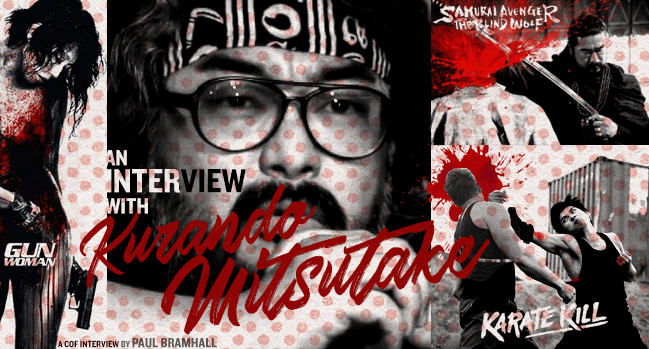
If you’re not familiar with the name Kurando Mitsutake, it’s about time you should be. His first two feature length productions – Samurai Avenger: Blind Wolf, and Gun Woman – have both been released in the States, and his latest movie, Karate Kill, as of the time of writing is just weeks away from also hitting the shelves on Blu-ray and DVD. It’s been a long time since any new Japanese director has so successfully seen all of their movies gain a release Stateside, so what exactly is Mitsuktake’s secret to making his movies appeal to such a broad audience?
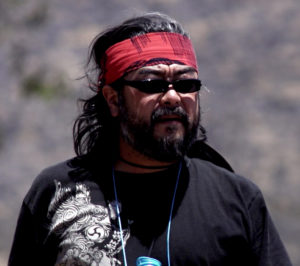
Kurando Mitsutake
One look at any of the titles mentioned, and the answer becomes apparent pretty quickly. Usually dealing in tales of bloody revenge, Mitsutake’s no holds barred approach to violence, nudity, and minimal dialogue has proven to be a killer combination. It was his 2014 feature Gun Woman that put him on the map, thanks in no small part due to featuring Japanese starlet Asami going on a violent rampage…completely naked. Now Karate Kill looks to cement his reputation as a man who knows how an action movie should be handled. Although there’s no promise that its star, Karate black belt Hayate, will throw down in a similar state of undress, that certainly shouldn’t be a deterrent to those looking for some hardboiled action.
In June 2017 I had a chance to interview Mitsutake in anticipation of Karate Kill being released in the U.S. A down to earth and amicable fellow, it gave me the opportunity to ask about his influences, martial arts, and where the Japanese film industry is headed for genre productions such as his. Check out our discussion below –
Paul Bramhall: When I watched Karate Kill, it felt like a modern day version of a 70’s Sonny Chiba movie, like The Streetfighter series, in terms of its mix of violence, gore, and nudity. Was this intentional, or were there any other movies that you felt influenced your approach?
Kurando Mitsutake: I’m very honoured if my movie reminded of you the legendary Sonny Chiba movies. When you do a martial arts film, you cannot deny or escape influences from Sonny Chiba and Bruce Lee no matter what you do, I think. But for Karate Kill, the movie I consciously drew my inspiration from was Dirty Harry. Harry Callahan is a great archetype of a self-righteous hero, and my hero in Karate Kill, Kenji, is like him. In a sense, what I wanted to do was to make Kenji’s Karate be Harry’s 44. Magnum. He wouldn’t be Dirty Harry without the .44 Magnum, but the movies aren’t about the Magnum.
PB: You’ve stated in previous interviews that you have no particular interest in martial arts movies, however you’ve made a very enjoyable one with Karate Kill. Now having made one, do you feel inclined to make more, or do you see this as a one-off venture into the genre?
KM: Yes, I’m not a huge martial arts movie fan. I love Sonny Chiba and Bruce Lee classics and some early Jackie Chan films – including his first attempt to cross over to Hollywood, The Protector. But I stopped following the genre avidly after people started to fly in the air with wirework stunts. Somehow, the denial of gravity didn’t sit well with me, it looked too made up. This is why, in Karate Kill, we only did what humans can do for real. So if I can keep this approach to the action, I would love to do more martial arts movies.
PB: Knowing this, so what were your first thoughts when the man who would become Karate Kill’s executive producer, Naoki Kubo, approached you with the idea to make a movie with Hayate?
KM: Kubo-san wanted to create a chemical reaction between a real martial artist and a crazy director who just did an insane movie called Gun Woman. And I loved the challenge. So I took the offer in a heartbeat.
PB: I really enjoyed Hayate’s initial visit to the hostess bar that his sister used to work in, and the confrontation it leads to, from the basement carpark, into the club itself, before ending up in the manager’s office. The whole sequence lasts for about 5 minutes, but how long did it actually take to film, and how many takes did you go through?
KM: I believe those scenes combined, we shot those in a day or little less. I shoot my movies crazy fast. Hollywood shoots about a page and half to 3 pages a day but I shoot 5 to 15 pages a day. We shot Karate Kill in 18 days in Los Angeles and 1 day in Tokyo. This style is not my choice, but it’s only what a Japanese indie film budget could allow me to do.
PB: There are many tales in the martial arts genre of when a real martial artist attempts the transition to screen-fighting, and the difficulties that such a change comes with. The need to pull punches, or get the right reaction to receiving a hit for example. What kind of challenges did Hayate face in transferring his style of Karate to the screen?
KM: I love this question because we had a huge issue with this one. Hayate is the real deal. His Karate is not for competitions. It’s for real self-defense, so his attacks are lethal. On the first offense he goes for the throat, the neck, the balls, the eyes and the heart. If I filmed his REAL fighting style, Karate Kill would have been a 40-minute short film. The biggest challenge that faced me and my fight choreographer, Keiya Tabuchi, was to fictionalize Hayate’s Karate while keeping its integrity.
Perhaps the funniest part of it was, let’s say there’s a punching scene, you don’t normally punch at the face, you would punch to the side. But because Hayate is the real deal, he prefers that it actually comes at his face, because he’s 100% sure he can dodge it. But the stuntman’s instinct is to punch to the side, which is where his face is going to go when he dodges! So that was a difficult adjustment. We had to ask the stunt people to actually go for his face, which I think made our fights a little more realistic. All in all Hayate and Keiya worked very closely for about 3 months to get ready for the filming, and I’m quite happy with the result.
PB: You worked with both Hayate and fight choreographer Keiya Tabuchi on the action scenes in Karate Kill. Can you tell us what was the process like to create these scenes? Did you have an idea in mind of what you wanted, then Hayate and Tabuchi would create the action based on your ideas, or did they also bring their own ideas to the table?
KM: Before I started to work on the script, I talked to Hayate extensively about what he wants to show in the movie. What type of attacks and situations. Then I reflected those in the writing. My script is pretty detailed, even on the fight scenes. I describe attacks, defences, and results, like what part of the body gets what type of damage. Keiya took what was on the script and designed the choreography around that. Then Hayate interjected his expertise onto it. This was how we achieved our fight scenes.
PB: You’ve worked with Tabuchi both on Gun Woman and Karate Kill, which tells me you have a good relationship as director and action director. How much would you say you influence each other’s approach to putting together an action scene, and what do you enjoy most about his style?
KM: I think my working relationship with Keiya is like a I’m Jim Steinman and he’s Meat Loaf kind of thing. I write songs and he sings them. His amazing ability elevates the songs to a higher level. That’s how I feel about our collaborations. What I love about Keiya as an action director is the fact that he is a storyteller. He tries to push the narrative forward within the action sequences.
Also, in this collaboration, I do need to mention my other amazing partner in crime, my director of photography Toshiyuki Imai. I imagine the fights, Keiya materializes them, and then they need to be filmed. That’s when Toshi comes in. Photographing staged fights well requires special understanding of what to shoot and what not to shoot. Since actors are not really hitting or kicking or killing each other, the camera work needs to sell the action. And Toshi does an excellent job doing just that.
PB: Speaking of camera work, the action sequence in the club during which the camera does a full 360 rotation features quite prominently in the promotional clips for Karate Kill, and understandably so as I believe it’s the first time I’ve seen such a technique in an action movie. How did that come about?
KM: Well, there are so many martial arts movies, and I wanted to try to be different. I didn’t want to be buried under mountains of martial arts movies. I wanted to approach it like a director who doesn’t normally shoot martial arts movies. I didn’t want this shaky camera bullsh*t. You can make anyone look strong with that. If you look at Bruce Lee movies, the camera work is simple. You just park the camera in front of the real deal, that’s it. I wanted to do something like that, but I didn’t want to just do the fixed shot. I wanted to follow the action, but I didn’t want to make it all blurry bullsh*t. The rotating camera thing, that shot to me signifies a descent into a crazy world. Kenji’s entering a world of killing, and blood, his world is turning upside down.
But also, I wanted to film one long fight scene in the movie, with no cuts. I loved the hammer fight in Oldboy, but our budget is probably like 1/100th of that movie, so we couldn’t do the long hallway, one continuous shot or anything. I was like, “I really want to move the camera and do one long take,” but there was no way to do that, so I said “Why don’t we just rotate it like this?”
PB: Japan has produced a worthy amount of onscreen action talent in the last 20 years. The likes of Tak Sakaguchi, Tatsuya Naka, Mitsuki Koga, and Rina Takeda can all deliver the goods. However they’ve failed to make the same impact that guys like Tony Jaa and Iko Uwais have. Why do you think this is?
KM: This is a very hard question to answer in a few sentences, but I believe mainly the bipolarization of the Japanese movie industry is to be blamed. Big movies are getting bigger and small movies are getting smaller. Those amazing Japanese action performers you mention are not given the chance to star in big movies because only bankable “flavor-of-the-month” big management company backed talent can get the major roles. So Japanese action actors are not getting the recognition they deserve with a wider audience. Also the fact that Japan doesn’t make that many well-funded action movies anymore is another major factor in this issue.
PB: Speaking of which, overseas distributors of Japanese movies often complain they’re given little to work with in terms of marketing material, in comparison to say Korea, meaning they have to work much harder to make a Japanese movie appeal to a foreign audience. What’s your opinion on this, and do you think there’s a reason why Japan doesn’t really promote its movies overseas?
KM: The lack of PR materials might have to do with the fact that movies are no longer that important in Japanese society. I believe cinephiles are a dying breed in Japan, so there is very little demand for the behind the scene record of movies. Also, the huge problem is the fact that not many current Japanese movie producers care about the world market. They make movies for the domestic market and recoup all the necessary revenue so the business is done. They don’t want to sweat international sales and what not. This is why Japanese movies don’t cross overseas. This is a shame because movies are not just commodities. Cinema creates cultural empathy. We need more of this, more than ever. So I whole-heartedly wish Japanese movies travelled more and farther in the world.
PB: Karate Kill features former WWE star Katarina Leigh Waters, and also Danish actor David Sakurai, who features in the underrated Danish movie Fighter and more recently in Marvel’s Iron Fist, how did they both get involved with the production?
KM: I was a fan of Katarina to begin with. I knew of her work on Katarina’s Nightmare Theater. So when she came to read for the part, pretty much just as she opened the door, I made my mind up to ask her to play the part of Simona. She was just perfect. She is a total pro, a delight to work with and she is very beautiful. Then on top all of that, she is an amazing fighter. I loved working with her and I can’t wait to collaborate with her again in the near future.
When my second feature Samurai Avenger: The Blind Wolf came out in Denmark, David saw it and loved it. He found me on Facebook and we became good SNS friends. Ever since then we’ve been seeking for an opportunity to work together and the guest starring role on Karate Kill provided us with a perfect chance. For that part, my Japanese producers actually wanted to cast someone famous in Japan. But I told them we would be so lucky if David came on board on Karate Kill because he is the next Keanu Reeves. And look at what’s happening to his career now. David Sakurai is going to be huge. I can only hope we can team up again soon.
PB: Then of course you have Asami. Like many, my first exposure to her was in 2008’s Machine Girl, and your movie Gun Woman went a long way to solidifying her image as the femme fatale of Japan’s B-movie action scene. Considering she started off in pink eiga, what is it do you think that makes her so appealing to audiences, and what is she like to work with?
KM: Asami is a force of nature. She is like gravity. Your sight goes to her and is drawn to her. Men, women, young and old. They all love her. And her skill as a performer to articulately convey emotions to an audience worldwide is simply magnificent. She is a sensitive young woman in person, but on the set she’s a tough leading lady. I love working with her.
PB: Even for someone that doesn’t know your love of horror, upon watching Karate Kill it becomes very apparent in various scenes. Was it a conscious decision to make the action so bloody and visceral, and did you have any influences in regards to gorier elements of the story?
KM: Hayate’s Karate is bloody and visceral so consequently, the movie became that way (laughs). For example, the ear ripping Hayate does in the movie is one of the real techniques he has. Same for the eye poke. So even without my love of horror movies, Karate Kill was bound to be a bloody one.
PB: On the topic of horror, in the early 00’s it seemed that Japan was going to have a resurgence as a country known for making the scariest horror flicks, a resurgence that sadly didn’t last due to an over reliance on the long black haired ghost trope. How do you see the future of horror in Japan, and how do you see yourself playing a part in it?
KM: Yes, the Sadako-esque long black haired ghosts are dead horses, but the Japanese love to keep on beating them. As a huge fan of the horror genre, I would love to contribute to the resurgence of Japanese horror if I were given an opportunity. But I’m not sure if Japan is ready for another horror movie wave anytime soon because the political climate there is taking a severe turn, and Japan’s acting more and more like a totalitarian society with some recent bills that have been passed. Right now movie audiences in Japan are turning away from the horror genre and heading towards more lighter and funnier content.
PB: If you were given an unlimited budget to work with and you could make whatever movie you want, what kind of movie would it be, and what would be your dream cast?
KM: My late father was a P.O.W. held by the Soviets after the WWII. So if I have an unlimited budget, I would love to make a WWII war drama about Japan, China and The Soviet Union. I have to think about my dream cast, but I would love to have a scene with Toshiro Mifune’s picture in it. As a homage to the most famous Japanese actor ever lived. Although I don’t think I want to go to the extent of having a CG version of Mr. Mifune as Star Wars: Rogue One did for Peter Cushing.
PB: I’d like to ask a question which you may only be able to half answer. Firstly, we’ve enjoyed Samurai Avenger: The Blind Wolf, Gun Woman, and now Karate Kill, so what can we expect next from you as a director. The second part is, Karate Kill has the potential to make a star out of Hayate, so do you have any plans to work with him again, or know what he has in store next?
KM: I had my 5th feature lined up at the end of last year. I was set to direct this really tight political action thriller in Japan but my star backed out at the last moment. The plug was pulled and it died completely. I was devastated and it took me a few months to recover, but I started pitching my future projects to different producers and companies again. So hopefully I will get a green light on one very soon. I think my next feature will be either my first full-on horror movie, or a hardboiled actioner. I would love to team up with Hayate again. He is one of the most committed film personas I’ve ever met. I totally respect him and wish him all the luck. I’m not sure what he has lined to do next but he is gaining momentum to do something big.
Thank you so much for this detailed and fun interview! And thank you very much for reading this. I hope you’ll enjoy Karate Kill!
Thanks again to Kurando Mitsutake, Paul Bramhall, and Clint Morris for their hard work in making this interview happen.

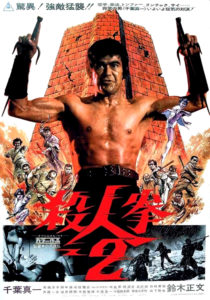
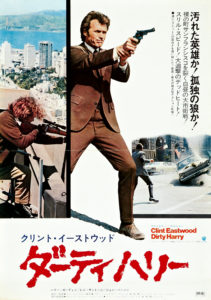
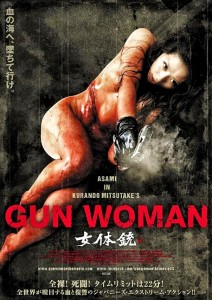
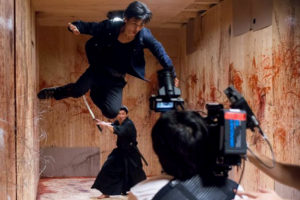
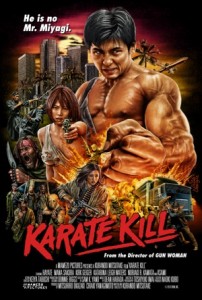
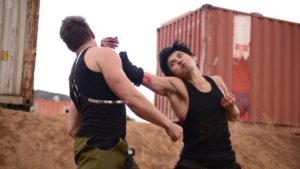
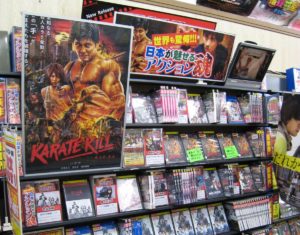
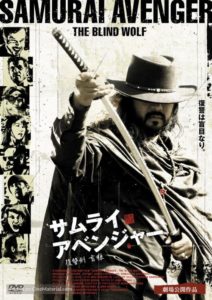

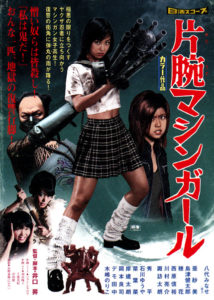
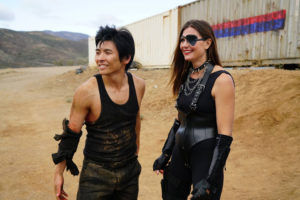



Great interview with Kurando, Paul. I’m glad you two were able to have a pretty in-depth conversation. After watching Karate Kill and Gun Woman recently, I am now a big fan of Kurando Mutsutake and look forward to whatever he does next. I personally would love to see a sequel to Gun Woman (with Hayate in some kind of supporting role). The ending to Gun Woman really seemed to be setting up something of a sequel…!